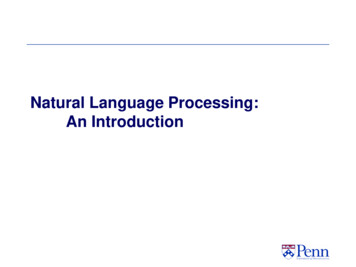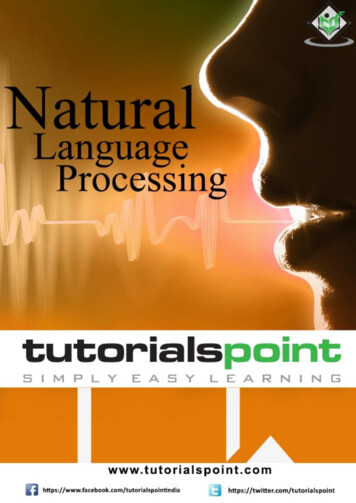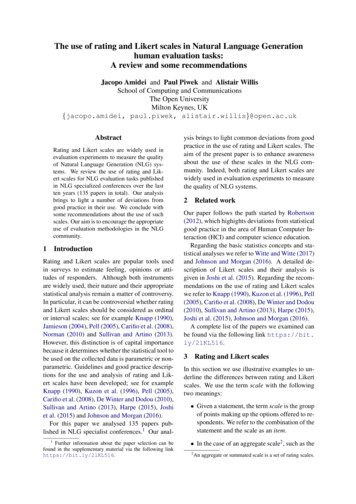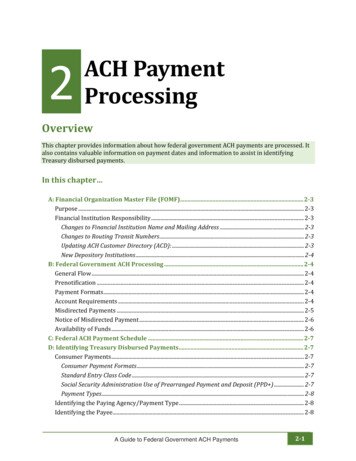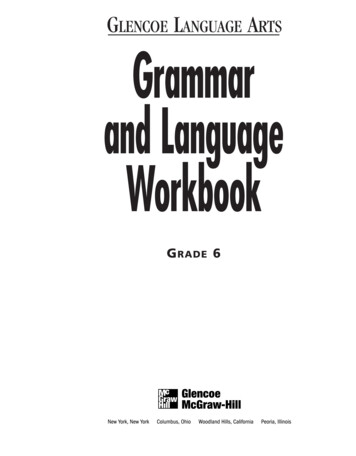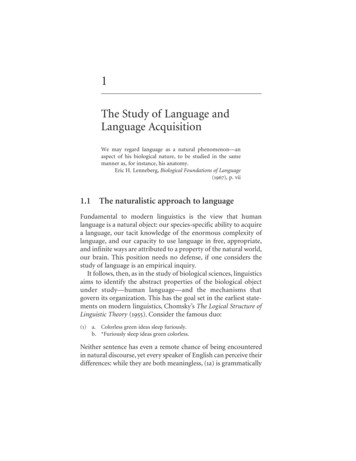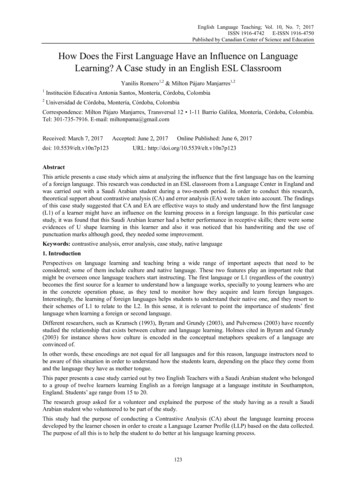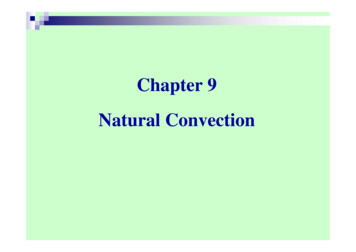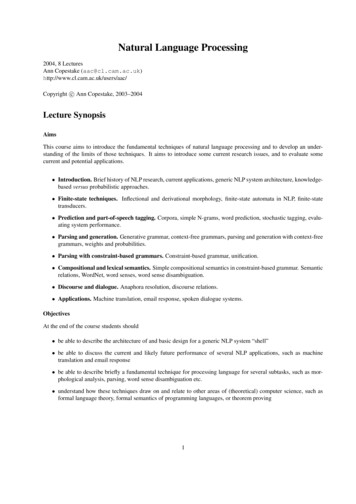
Transcription
Natural Language Processing2004, 8 LecturesAnn Copestake c/Copyright c Ann Copestake, 2003–2004Lecture SynopsisAimsThis course aims to introduce the fundamental techniques of natural language processing and to develop an understanding of the limits of those techniques. It aims to introduce some current research issues, and to evaluate somecurrent and potential applications. Introduction. Brief history of NLP research, current applications, generic NLP system architecture, knowledgebased versus probabilistic approaches. Finite-state techniques. Inflectional and derivational morphology, finite-state automata in NLP, finite-statetransducers. Prediction and part-of-speech tagging. Corpora, simple N-grams, word prediction, stochastic tagging, evaluating system performance. Parsing and generation. Generative grammar, context-free grammars, parsing and generation with context-freegrammars, weights and probabilities. Parsing with constraint-based grammars. Constraint-based grammar, unification. Compositional and lexical semantics. Simple compositional semantics in constraint-based grammar. Semanticrelations, WordNet, word senses, word sense disambiguation. Discourse and dialogue. Anaphora resolution, discourse relations. Applications. Machine translation, email response, spoken dialogue systems.ObjectivesAt the end of the course students should be able to describe the architecture of and basic design for a generic NLP system “shell” be able to discuss the current and likely future performance of several NLP applications, such as machinetranslation and email response be able to describe briefly a fundamental technique for processing language for several subtasks, such as morphological analysis, parsing, word sense disambiguation etc. understand how these techniques draw on and relate to other areas of (theoretical) computer science, such asformal language theory, formal semantics of programming languages, or theorem proving1
OverviewNLP is a large and multidisciplinary field, so this course can only provide a very general introduction. The firstlecture is designed to give an overview of the main subareas and a very brief idea of the main applications andthe methodologies which have been employed. The history of NLP is briefly discussed as a way of putting this intoperspective. The next six lectures describe some of the main subareas in more detail. The organisation is roughly basedon increased ‘depth’ of processing, starting with relatively surface-oriented techniques and progressing to consideringmeaning of sentences and meaning of utterances in context. Most lectures will start off by considering the subarea asa whole and then go on to describe one or more sample algorithms which tackle particular problems. The algorithmshave been chosen because they are relatively straightforward to describe and because they illustrate a specific techniquewhich has been shown to be useful, but the idea is to exemplify an approach, not to give a detailed survey (which wouldbe impossible in the time available). (Lecture 5 is a bit different in that it concentrates on a data structure instead ofan algorithm.) The final lecture brings the preceding material together in order to describe the state of the art in threesample applications.There are various themes running throughout the lectures. One theme is the connection to linguistics and the tensionthat sometimes exists between the predominant view in theoretical linguistics and the approaches adopted within NLP.A somewhat related theme is the distinction between knowledge-based and probabilistic approaches. Evaluation willbe discussed in the context of the different algorithms.Because NLP is such a large area, there are many topics that aren’t touched on at all in these lectures. Speechrecognition and speech synthesis is almost totally ignored. Information retrieval and information extraction are thetopic of a separate course given by Simone Teufel, for which this course is a prerequisite.Feedback on the handout, lists of typos etc, would be greatly appreciated.Recommended ReadingRecommended Book:Jurafsky, Daniel and James Martin, Speech and Language Processing, Prentice-Hall, 2000 (referenced as J&M throughout this handout).Background:These books are about linguistics rather that NLP/computational linguistics. They are not necessary to understand thecourse, but should give readers an idea about some of the properties of human languages that make NLP interestingand challenging, without being technical.Pinker, S., The Language Instinct, Penguin, 1994.This is a thought-provoking and sometimes controversial ‘popular’ introduction to linguistics.Matthews, Peter, Linguistics: a very short introduction, OUP, 2003.The title is accurate . . .Background/reference:The Internet Grammar of English, actic concepts and terminology.Study and Supervision GuideThe handouts and lectures should contain enough information to enable students to adequately answer the examquestions, but the handout is not intended to substitute for a textbook. In most cases, J&M go into a considerableamount of further detail: rather than put lots of suggestions for further reading in the handout, in general I haveassumed that students will look at J&M, and then follow up the references in there if they are interested. The notes atthe end of each lecture give details of the sections of J&M that are relevant and details of any discrepancies with thesenotes.Supervisors ought to familiarise themselves with the relevant parts of Jurafsky and Martin (see notes at the end of eachlecture). However, good students should find it quite easy to come up with questions that the supervisors (and the2
lecturer) can’t answer! Language is like that . . .Generally I’m taking a rather informal/example-based approach to concepts such as finite-state automata, context-freegrammars etc. Part II students should have already got the formal background that enables them to understand theapplication to NLP. Diploma and Part II (General) students may not have covered all these concepts before, but theexpectation is that the examples are straightforward enough so that this won’t matter too much.This course inevitably assumes some very basic linguistic knowledge, such as the distinction between the major partsof speech. It introduces some linguistic concepts that won’t be familiar to all students: since I’ll have to go throughthese quickly, reading the first few chapters of an introductory linguistics textbook may help students understand thematerial. The idea is to introduce just enough linguistics to motivate the approaches used within NLP rather thanto teach the linguistics for its own sake. At the end of this handout, there are some mini-exercises to help studentsunderstand the concepts: it would be very useful if these were attempted before the lectures as indicated. There arealso some suggested post-lecture exercises.Exam questions won’t rely on students remembering the details of any specific linguistic phenomenon. As far aspossible, exam questions will be suitable for people who speak English as a second language. For instance, if aquestion relied on knowledge of the ambiguity of a particular English word, a gloss of the relevant senses would begiven.Of course, I’ll be happy to try and answer questions about the course or more general NLP questions, preferably byemail.3
1 Lecture 1: Introduction to NLPThe aim of this lecture is to give students some idea of the objectives of NLP. The main subareas of NLP will beintroduced, especially those which will be discussed in more detail in the rest of the course. There will be a preliminarydiscussion of the main problems involved in language processing by means of examples taken from NLP applications.This lecture also introduces some methodological distinctions and puts the applications and methodology into somehistorical context.1.1What is NLP?Natural language processing (NLP) can be defined as the automatic (or semi-automatic) processing of human language.The term ‘NLP’ is sometimes used rather more narrowly than that, often excluding information retrieval and sometimeseven excluding machine translation. NLP is sometimes contrasted with ‘computational linguistics’, with NLP beingthought of as more applied. Nowadays, alternative terms are often preferred, like ‘Language Technology’ or ‘LanguageEngineering’. Language is often used in contrast with speech (e.g., Speech and Language Technology). But I’m goingto simply refer to NLP and use the term broadly.NLP is essentially multidisciplinary: it is closely related to linguistics (although the extent to which NLP overtly drawson linguistic theory varies considerably). It also has links to research in cognitive science, psychology, philosophy andmaths (especially logic). Within CS, it relates to formal language theory, compiler techniques, theorem proving, machine learning and human-computer interaction. Of course it is also related to AI, though nowadays it’s not generallythought of as part of AI.1.2Some linguistic terminologyThe course is organised so that there are six lectures corresponding to different NLP subareas, moving from relatively‘shallow’ processing to areas which involve meaning and connections with the real world. These subareas looselycorrespond to some of the standard subdivisions of linguistics:1. Morphology: the structure of words. For instance, unusually can be thought of as composed of a prefix un-, astem usual, and an affix -ly. composed is compose plus the inflectional affix -ed: a spelling rule means we endup with composed rather than composeed. Morphology will be discussed in lecture 2.2. Syntax: the way words are used to form phrases. e.g., it is part of English syntax that a determiner such asthe will come before a noun, and also that determiners are obligatory with certain singular nouns. Formal andcomputational aspects of syntax will be discussed in lectures 3, 4 and 5.3. Semantics. Compositional semantics is the construction of meaning (generally expressed as logic) based onsyntax. This is contrasted to lexical semantics, i.e., the meaning of individual words. Compositional and lexicalsemantics is discussed in lecture 6.4. Pragmatics: meaning in context. This will come into lecture 7, although linguistics and NLP generally havevery different perspectives here.1.3Why is language processing difficult?Consider trying to build a system that would answer email sent by customers to a retailer selling laptops and accessoriesvia the Internet. This might be expected to handle queries such as the following: Has my order number 4291 been shipped yet? Is FD5 compatible with a 505G? What is the speed of the 505G?4
Assume the query is to be evaluated against a database containing product and order information, with relations suchas the following:ORDEROrder numberDate orderedDate SER: Has my order number 4291 been shipped yet?DB QUERY: order(number 4291,date shipped ?)RESPONSE TO USER: Order number 4291 was shipped on 2/2/02It might look quite easy to write patterns for these queries, but very similar strings can mean very different things,while very different strings can mean much the same thing. 1 and 2 below look very similar but mean somethingcompletely different, while 2 and 3 look very different but mean much the same thing.1. How fast is the 505G?2. How fast will my 505G arrive?3. Please tell me when I can expect the 505G I ordered.While some tasks in NLP can be done adequately without having any sort of account of meaning, others require thatwe can construct detailed representations which will reflect the underlying meaning rather than the superficial string.In fact, in natural languages (as opposed to programming languages), ambiguity is ubiquitous, so exactly the samestring might mean different things. For instance in the query:Do you sell Sony laptops and disk drives?the user may or may not be asking about Sony disk drives. This particular ambiguity may be represented by differentbracketings:Do you sell (Sony laptops) and (disk drives)?Do you sell (Sony (laptops and disk drives))?We’ll see lots of examples of different types of ambiguity in these lectures.Often humans have knowledge of the world which resolves a possible ambiguity, probably without the speaker orhearer even being aware that there is a potential ambiguity.1 But hand-coding such knowledge in NLP applicationshas turned out to be impossibly hard to do for more than very limited domains: the term AI-complete is sometimesused (by analogy to NP-complete), meaning that we’d have to solve the entire problem of representing the worldand acquiring world knowledge.2 The term AI-complete is intended jokingly, but conveys what’s probably the mostimportant guiding principle in current NLP: we’re looking for applications which don’t require AI-complete solutions:i.e., ones where we can work with very limited domains or approximate full world knowledge by relatively simpletechniques.1.4Some NLP applicationsThe following list is not complete, but useful systems have been built for:1 I’ll use hearer generally to mean the person who is on the receiving end, regardless of the modality of the language transmission: i.e., regardlessof whether it’s spoken, signed or written. Similarly, I’ll use speaker for the person generating the speech, text etc and utterance to mean the speechor text itself. This is the standard linguistic terminology, which recognises that spoken language is primary and text is a later development.2 In this course, I will use domain to mean some circumscribed body of knowledge: for instance, information about laptop orders constitutes alimited domain.5
spelling and grammar checking optical character recognition (OCR) screen readers for blind and partially sighted users augmentative and alternative
Recommended Book: Jurafsky, Daniel and James Martin, Speech and Language Processing, Prentice-Hall, 2000 (referenced as J&M through-out this handout). Background: These books are about linguistics rather that NLP/computational linguistics. They are not necessary to understand the course, but should give readers an idea about some of the properties of human languages that make NLP interesting .


